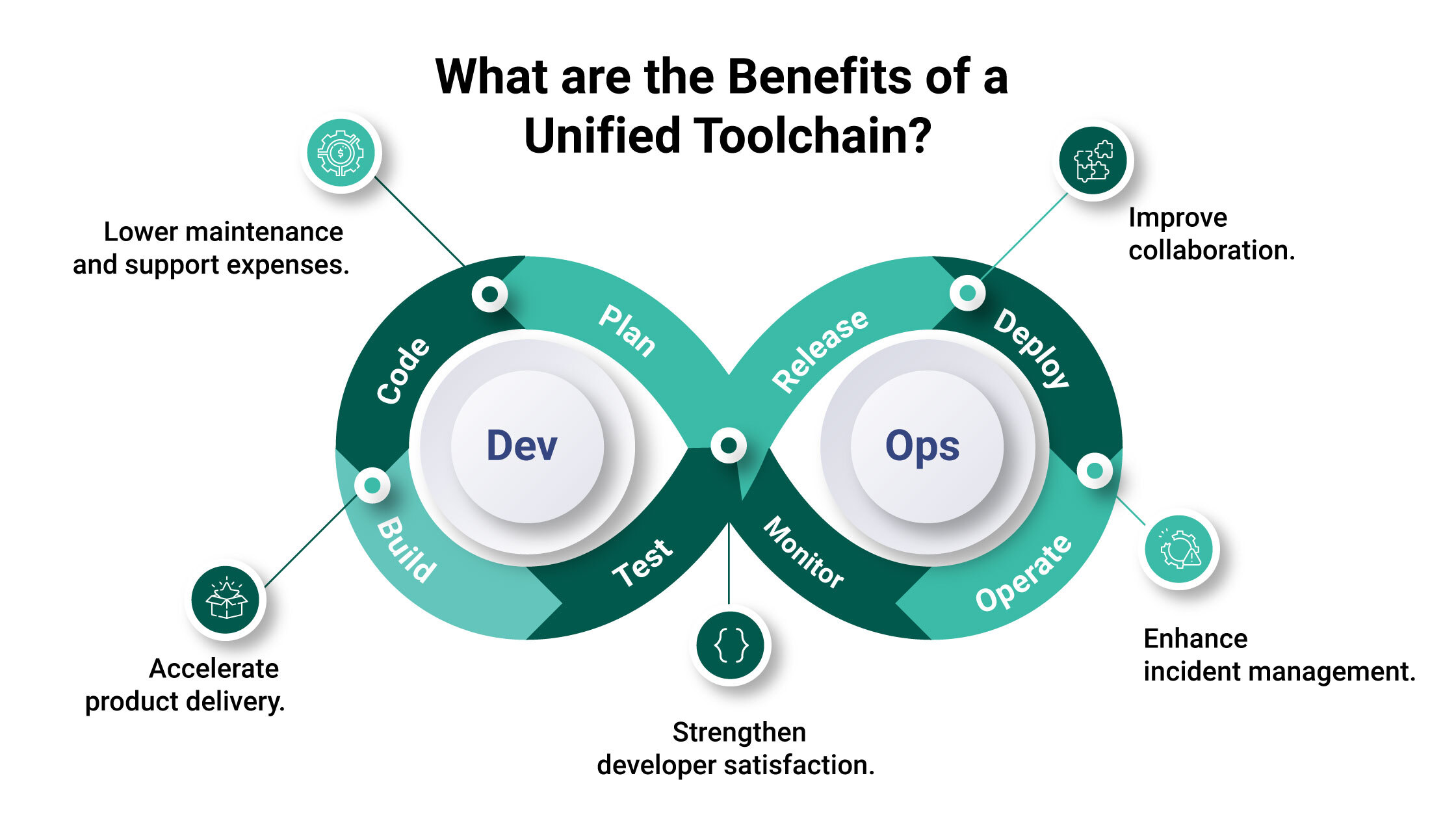The first thing that comes to mind when people hear the word “DevOps” is the software development lifecycle. While collaboration, integration, continuous improvement, etc. are essential aspects, DevOps is a very broad process involving more than just IT. It stretches out into the business, involving many different stakeholders, teams, and functions. This results in a toolchain that is wide-ranging, complex, and extremely difficult to manage and maintain. Read on as we delve into the various facets of the DevOps tools, the challenges of an unoptimized toolchain, and the steps you can take to optimize it.
What is a DevOps Toolchain?
Atlassian defines a DevOps toolchain as “a collection of tools, often from a variety of vendors, that operate as an integrated unit to design, build, test, manage, measure, and operate software and systems. It enables development and operations teams to collaborate across the entire product lifecycle and tackles key DevOps fundamentals, including continuous integration, continuous delivery, automation, and collaboration”.
What are the Different Options for Building a DevOps Toolchain?
Building the ideal DevOps toolchain can be daunting, given the wide range of available options. However, by considering a few key factors, you can make an informed toolchain decision that aligns with your organization’s needs and goals. When it comes to building a DevOps toolchain, here are two primary options at hand:
- An all-in-one DevOps toolchain that provides a complete solution but may not integrate with other third-party tools. For companies that are just beginning their DevOps journey, an all-in-one toolchain can be beneficial. However, for larger, established teams who already have a set of tools in place, an all-in-one solution might cause integration hassles.
- A customizable DevOps toolchain allows teams to tailor different tools to meet unique needs. Teams can bring existing tools they know and love into the wider DevOps toolchain. For example, they can use Jira for workflow tracking, Kubernetes for environment provisioning, and GitHub for collaborative coding. However, with such a toolchain, integration is key. If the different tools don’t integrate easily, teams end up spending a lot of time logging into different tools, switching between screens, and collaborating with peers.
Understanding DevOps Toolchain Optimization
Software development teams across the globe are under immense pressure to accelerate product delivery. As they embrace DevOps to meet the ever-increasing demands of their customers, they increasingly face a toolchain crisis. Most DevOps teams have the autonomy to select their own toolchains. The diversity of modern technology stacks further adds to the toolchain complexity as do enterprise silos.
Organic growth and maturity of modern DevOps and CI/CD tools play a major role in the expansion of tools within each toolchain. Tools that were once restricted to continuous integration and continuous delivery have now expanded to shift-left performance testing, security scanning, functional test automation, test management, collaboration, agile, etc.
The Consequences of Unoptimized Toolchains
DevOps tools are paramount to improving collaboration and accelerating software delivery. Yet, end-to-end visibility of software delivery continues to be a major challenge. The reliance of different teams and functions on different tools for project management, code review, testing, etc. causes several problems.
- Teams spend too much time and resources piecing together disparate tools from different stages of the DevOps lifecycle. This leads to unnecessary stress while preventing them from achieving their full potential.
- Since critical data is stored in different tools, getting end-to-end visibility into the DevOps lifecycle becomes difficult. This impacts development efficiency, dilutes productivity, and delays time-to-market.
- Since each tool maintains its security differently, it complicates access control. Teams often get frustrated navigating the different security mechanisms which impacts overall productivity and efficiency.
- Unoptimized toolchains also lead to complex handoffs between teams using different tools, eventually slowing down the pace of development.
What are the Benefits of a Unified Toolchain?
DevOps works on the principle of breaking down silos, so different teams can work seamlessly together. Unoptimized toolchains negate this principle, making the development life cycle sluggish and less collaborative.
An optimized DevOps toolchain helps teams overcome the challenges that come with implementing, operating, and maintaining many tools. Designed from the ground up as a unified application, an optimized toolchain offers a range of critical DevOps capabilities. From project planning and source code management to version control and CI/CD — since all capabilities are built-in, it eliminates the need to integrate multiple tools.

A unified DevOps toolchain like those offered by Atlassian, AWS, GitLab, JetBrains, or JFrog, comprises tools that work seamlessly together. They allow teams to collaborate across the development, testing, and deployment stages, tackle issues quickly, and build, test, and release software faster and more reliably. Let’s look at the top benefits of a unified toolchain:
- A unified DevOps toolchain leads to lower maintenance and support expenses.
- Since teams only use a minimal set of tools, they can improve collaboration and accomplish goals faster.
- The massive reduction in the time and effort spent in operating different tools also helps accelerate product delivery.
- Since teams can get their work done quickly and with less administrative burden, a unified DevOps toolchain also helps strengthen developer satisfaction.
- Better visibility across the DevOps lifecycle also helps enhance incident management, leading to quicker identification and resolution of defects.
How can Organizations Build and Optimize a Successful Toolchain?

Building and optimizing a successful DevOps toolchain requires teams to take several steps. Here are some things to keep in mind:
- Revitalize your CI/CD pipeline: The first thing DevOps teams must do is identify constraints and bottlenecks before eliminating inefficiencies. For instance, revisiting the CI/CD pipeline can allow teams to uncover opportunities to become more efficient. By capturing and acting on real-time value stream data from across the software delivery lifecycle, they can pinpoint existing issues and accordingly plan for integration.
- Find opportunities to swap custom-built software with purpose-built off-the-shelf solutions, minimizing maintenance and support expenses: Standardizing processes across the DevOps ecosystem can help enhance the DevOps toolchain and elevate the team’s performance. By swapping custom-built software with purpose-built off-the-shelf solutions, teams can minimize maintenance and support expenses.
- Uncover ways to automate tasks and accelerate delivery times: Streamlining workflows via automation across the software development lifecycle is a great way to resolve the toolchain crisis. With typical projects undergoing hundreds of changes each day, task automation can help teams tackle different parts of the development lifecycle quickly bridge development and operations by providing continuous feedback and logging, and accelerate delivery times.
- Spot integration possibilities among tools to boost developer efficiency: Most DevOps teams rely on tools with overlapping features and capabilities. Identifying such tools and uncovering integration possibilities can minimize tool sprawl while empowering teams to leverage a handful of critical capabilities for increased development efficiency.
- Conduct discovery interviews to assess the current state of workflows: Conducting discovery interviews with key stakeholders across the DevOps lifecycle can provide insight into existing workflows and tools. Through detailed assessment of tasks across planning, version control, testing, security, deployment, etc., it can help in identifying integration and automation possibilities, leading to cleaner and simpler workloads.
- Embrace shift left testing to detect and fix issues early in the development lifecycle: Shift left testing is another way to build and optimize a successful DevOps toolchain. By receiving real-time visibility into the performance and behavior of the application or system being tested, software teams can pinpoint and fix issues early in the development process. This way, they can improve the quality and reliability of the product, while reducing the time and effort required for testing.
- Opt for tools with open standards for greater collaboration and innovation: DevOps tools built using open standards can help curtain toolchain sprawl. They streamline communication and interoperability since they are built on common and widely accepted protocols, formats, and interfaces. This leads to higher efficiency, security, and scalability of DevOps processes and better collaboration and innovation.
In Summary
The pressure on DevOps teams to develop and deploy high-quality, innovative solutions is constantly growing. To stay ahead in a competitive landscape, they need to embrace different tools across each stage of the development lifecycle, which causes unnecessary toolchain sprawl.
A unified DevOps toolchain, on the other hand, tightly integrates a range of top-performing DevOps tools, elevating the team’s performance. It can lower maintenance efforts and support expenses while accelerating product delivery and boosting developer satisfaction.
Experience the power of a unified DevOps toolchain with enreap! Explore our range of Agile and DevOps Consulting Services to limit the complexity of your toolchain and drive continuous innovation.




